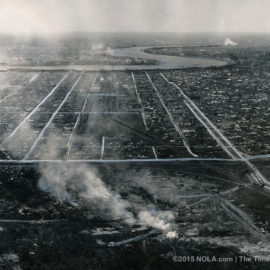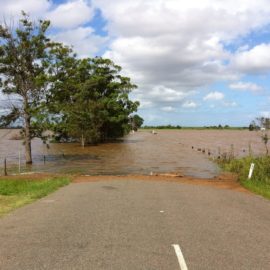
Driven out by land loss the first new homes are being occupied by the Isle de Jean Charles residents.
As his tribal chief burned sage in the doorway, Chris Brunet entered his new home, 40 miles inland from the storm-ravaged and sinking island where generations of Brunets have lived. “I knew this day was coming, but how I feel is different than I thought,” he said. “It’s not a celebration. It’s something else.” On Wednesday, Brunet was given a key to one of the first 12 homes completed at New Isle, the first federally funded resettlement site for a community threatened by climate change. Thirty-seven houses are planned for people who lived on the island on Aug. 28, 2012, when Hurricane Isaac struck. Another 25 empty lots could be given to residents who left before 2012. Residents get the homes and lots for free, but must cover taxes and insurance. They own the homes outright if they occupy them for five years. Awarded in 2016, the $48 million grant from the U.S. Department of Housing and Urban Development covered the purchase of the 515-acre property, a former sugar farm between Houma and Thibodaux, and the new homes, roads, sidewalks and ponds still taking shape on the resettlement site, which residents named New Isle.
nola.com
This is a bittersweet moment as they leave a site they have occupied for centuries for a new start on solid ground.
Gov. John Bel Edwards acknowledged that Wednesday’s event was “bittersweet” for many residents, most of whom are enrolled with the Jean Charles Choctaw Nation, a tribe that has seen almost all of its 700 members leave its namesake island in recent decades. “This is the very first program of its kind in the nation’s history, where we’re having to move people because of climate change,” Edwards told a small crowd of current and former island residents, local leaders and staff from the state Office of Community Development, which led the site’s development. “I wish it wasn’t necessary, but it is.” The island has lost 98% of its area since 1955 due to a combination of factors, including frequent hurricanes, erosion from oil and gas canals, and subsidence – the sinking and compacting of coastal land. Sea-level rise triggered by climate change is expected to drown the island in the coming years. Recent storms have hit hard, and high tides and southern winds routinely flood the island’s main road. Hurricane Ida destroyed or severely damaged most of the remaining homes. Brunet is one of the last half-dozen people still living on the island.
Others have move earlier staying in some proximity of the Isle.
The island has lost 98% of its area since 1955 due to a combination of factors, including frequent hurricanes, erosion from oil and gas canals, and subsidence – the sinking and compacting of coastal land. Sea-level rise triggered by climate change is expected to drown the island in the coming years. Recent storms have hit hard, and high tides and southern winds routinely flood the island’s main road. Hurricane Ida destroyed or severely damaged most of the remaining homes. Brunet is one of the last half-dozen people still living on the island. “Living down there on the island, we had happy times and unhappy times,” he said. “But now we’ll be safe from the water,” his wife added. The Naquins joined a church less than a mile from their new home. “We feel welcome here every day,” Mildred Naquin said.
Built to survive hurricanes and in a low flood area, these should be far better.
The homes were built to withstand 150 mph winds and are located in an area with relatively low flood risk. “That doesn’t mean it won’t flood here the day after tomorrow,” Edwards quipped, noting that even inland areas of south Louisiana are at increasing risk from heavy rainfall and stronger, more frequent storms. New Isle took much longer than expected to build, and it’s still not fully developed, said Albert Naquin, the tribe’s chief and Al Naquin’s cousin. Chief Naquin said he’s happy for the new homeowners, but any future resettlement efforts should see this one as a cautionary tale.
There are rules and regulations more strict than I have in my house.
Some residents worry about the many rules and conditions of home ownership at New Isle. Residents can’t live on, rent or make substantial improvements on their island properties if they accept a New Isle home. They fear losing their New Isle homes if they fail to meet full-time occupancy requirements and other conditions. Brunet questioned the governor about the rules. “So long as you keep up the place, you own it,” Edwards told Brunet. “And now you can’t go and erase Isle de Jean Charles,” Brunet said, noting the state’s desire to return the island to a natural, unpopulated condition. “It’s still there and we want to continue to enjoy it.” “I guarantee you will,” Edwards said.
It is good that this action could happen but sad that it was necessary.



